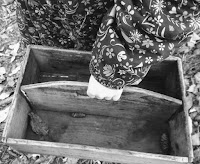I enjoy the time before building day- when children eagerly bring in baskets of treasures to share and count with their community. Almost every morning a child would come into our classroom cupping a special stone in their hand and ask, "Can we use this treasure for our greeting?"
I marvel at their sense of wonder when examining photographs of detailed Fairy Houses and their curiosity of cultures from around the world.
The building of Fairy Houses is the building of a story, of a child's plan- their hope. But, the work prior to building our Fairy Houses encourages the making of connections, learning about people and where they live, thinking about what makes a house feel like a home, and embracing the glimmers of magic and joy that exist around us at all times.
THE LITERATURE

During our weeks of preparation, we read an assortment of books about homes and structures- an apartment building is a home, but so is a shelter in the trees. We continued our conversations about nonfiction and fiction, and I ensured to include brief information about each book prior to reading.
We talked about how builders learn about different kinds of houses and they explore and discuss materials. Like a scientist, we were researching. But, what about researching fairies? Of course, the possibility that fairies aren't real came up. Many children quickly responded, you have to believe.
On the morning of our building day, I shared a short video Cindy once shared with me- Lydia the Fairy Scientist. Lydia is a Scientist, like all of the children, but she studies Fairies. She has theories and looks for evidence. Following the video I asked what we learned from Lydia- even if you don't agree or have a different theory, Lydia taught us something really important about being a scientist.
I learned that scientists keep looking, so, we have to just keep looking.
I learned scientists never give up!
COLLECTING, SORTING, AND COUNTING
An important part of our experience is the authentic and meaningful sorting and counting of materials. We used ten frames to organize our counting. With each material counted we remembered why we use ten frames, why the tool is called a ten frame, and how many on a full ten frame. We counted by 1's and by 10's. We counted up by 10's and we counted back by 10's. Children recorded how many on sticky notes and we stored our sorted materials in the science window.



On Friday, 11-9-18 we used our outdoor classroom time to collect pinecones for our fairy houses. During morning meeting children represented and labeled a pinecone, attaching their scientific drawing on our morning message. We looked at the many different lines the scientists used to draw and show a pinecone. Maeve shared how she wrote the word pinecone and where you could find it on your paper, if you wanted to use a label.
Their representations now live in their nature journals. While collecting later in the afternoon, we filled our baskets, bags, and bins- Bodhi even chose to fill our beloved singing bowl!
The next day I presented our collected cones in a large basket and the children made predictions of how many cones we collected. We recorded our predictions and put 10 ten frames in a row- how many boxes in all? I noted the children counting the boxes by 1's, the children counting by 10's, and the children that knew 100 automatically. If we filled this column, we would have 100 cones. We started our count.
It took multiple counts across two days. I stored groups of 100 and 200 in clear bins, inviting children to make a visual comparison. By the end we had counted 500 cones!
REPRESENTATION-
SCIENTIFIC DRAWING OF A PINECONE




COUNTING OUR COLLECTION















Oh my word what fun!!
ReplyDelete